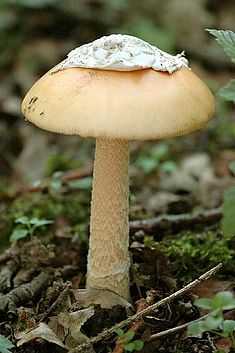Amanita ovoidea
| ||||||||||||||||||||||||||||||||||||||||||||||||
The European white egg (Amanita ovoidea), Bearded Amanita or European Egg Amidella, is a species of mushroom of the genus Amanita in the family Amanitaceae. It is a white-colored fungus tinged with cream. Native to Europe, it is found on plain land like grass or roads in mainly southern part of Europe. The species was first introduced in 1833 by Pierre Bulliard, a French physician and botanist, and Lucien Quélet, a French mycologist and naturalist.
Description
The color of the mushroom is white to cream. The size is over 15 centimeters. The cap is 10 to 12 centimeters, smooth, fleshy, sticky, and convex to shield shaped. The color of the spores are white, cream, or yellowish. The stipe is thick, cylindrical, powdery, has a ring, and a has a volva. The lamellae are thick, rounded, broad and are attached to the stipe. The volva is large, tall, and fleshy. The mushroom is symbiotic.[2][3][4] The cap yellows with old age. The cuticle is smooth and shiny.[5] The gills are free and crowded. The spores are broadly elliptical and amyloid. The spore print is white.[2] This species of mushroom is commonly found in woods, roadsides, and lawns.[2] It commonly grows under oak trees and chestnut trees in hilly areas.[4]
Distribution and status
A. ovoidea is found in coniferous forests, deciduous forests (notably under oaks), coastal regions, roadsides and grassy areas.[6][2] They grow on limy, sandy and alkaline soils.[7]
The species is in danger due to habitat loss, which is being caused by selective logging, human settlements and natural causes like acid rains, soil pollution.[7]
Edibility
The species is said to be edible, however it can easily be confused with poisonous Amanita species. The writers of Roger's Mushrooms advise people not to attempt to eat this species because of this danger.[2] Two deadly species that the mushroom may be confused with are Amanita virosa and Amanita proxima.[8] In southern France, some people were inflicted with acute renal insufficiency because they accidentally ate A. proxima, thinking it was this species.[9]
For those people who do eat it, it has been said that the flesh of this mushroom needs to be seasoned well with butter and salt to overcome an insipid taste.[10] Other sources however, describe the mushroom as delicious.[11] The flesh has a faint odor.
A study on the minerals in mushrooms of northwest Turkey included this species.[12] The conclusions were that the mushrooms were very healthy and should be eaten to fulfill nutritional needs.
See also
References
- ↑ "Amanita ovoidea" (in German). Agraria.org.
- ↑ 2.0 2.1 2.2 2.3 2.4 "Amanita ovoidea". Roger's Mushrooms. Retrieved 2010-05-24.
- ↑ "Amanita ovoidea (Bull.: Fr)". Agraria. Retrieved 2010-05-24.
- ↑ 4.0 4.1 "Amanita ovoidea". Fungo Center. Retrieved 2010-05-24.
- ↑ "Amanita ovoid, Br: Bull.". micoValdorba. Retrieved 2010-05-24.
- ↑ R E, Tulloss. "Amanita ovoidea".
- ↑ 7.0 7.1 "Amanita ovoidea". Red Data Book of Bulgaria.
- ↑ Pérez Calvo200, Javi (2009-01-23). "Amanita ovoid". Fungipedia. Retrieved 2010-05-24.
- ↑ "Acute renal insufficiency caused by Amanita proxima poisoning: experience of the Poison Center of Marseille]". Nephrologie 19 (1): 21–4. 1998. PMID 9551448.
- ↑ New York State Museum of Natural History, New York State Museum, New York State Museum and Science Service (1913). Bulletin, Issues 167-170. The University of the State of New York. p. 51.
- ↑ Thomas Burnett, Gilbert (1835). Outlines of botany. John Churchill. p. 260.
- ↑ "Minor element and heavy metal content of edible wild mushrooms native to Bolu, North-West Turkey". Fresenius Environmental Bulletin 17 (2): 249–252. 2008. Retrieved 2010-05-24.

